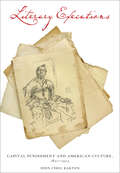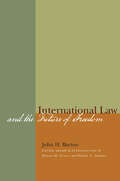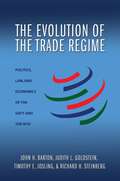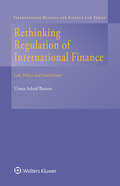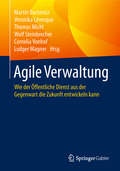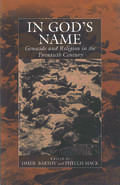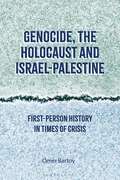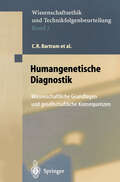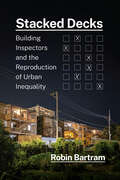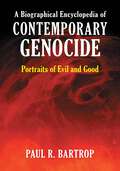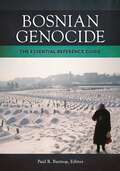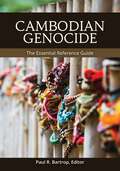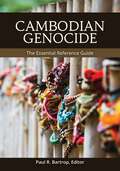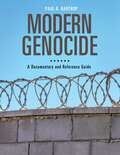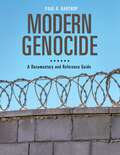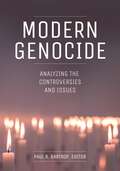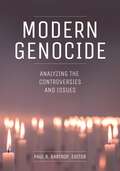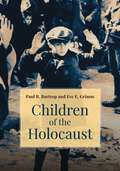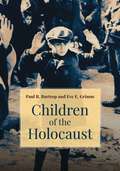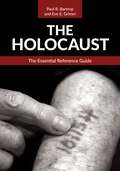- Table View
- List View
Literary Executions: Capital Punishment and American Culture, 1820–1925
by John Cyril BartonDrawing from legal and extralegal discourse but focusing on imaginative literature, Literary Executions examines representations of, responses to, and arguments for and against the death penalty in the United States over the long nineteenth century. John Cyril Barton creates a generative dialogue between artistic relics and legal history. He looks to novels, short stories, poems, and creative nonfiction as well as legislative reports, trial transcripts, legal documents, newspaper and journal articles, treatises, and popular books (like The Record of Crimes, A Defence of Capital Punishment, and The Gallows, the Prison, and the Poor House), all of which were part of the debate over the death penalty.Barton focuses on several canonical figures—James Fenimore Cooper, Nathaniel Hawthorne, Lydia Maria Child, Walt Whitman, Herman Melville, and Theodore Dreiser—and offers new readings of their work in light of the death penalty controversy. Barton also gives close attention to a host of then-popular-but-now-forgotten writers—particularly John Neal, Slidell MacKenzie, William Gilmore Simms, Sylvester Judd, and George Lippard—whose work helped shape or was shaped by the influential anti-gallows movement. Analyzing the tension between sovereignty and social responsibility in a democratic republic, Barton argues that the high stakes of capital punishment dramatize the confrontation between the citizen-subject and sovereign authority in its starkest terms. In bringing together the social and the aesthetic, Barton shows how legal forms informed literary forms and traces the emergence of the modern State in terms of the administration of lawful death.By engaging the politics and poetics of capital punishment, Literary Executions contends that the movement to abolish the death penalty in the United States should be seen as an important part of the context that brought about the flowering of the American Renaissance during the antebellum period and that influenced literature later in the nineteenth and early twentieth centuries.
Literary Executions: Capital Punishment and American Culture, 1820–1925
by John Cyril BartonDrawing from legal and extralegal discourse but focusing on imaginative literature, Literary Executions examines representations of, responses to, and arguments for and against the death penalty in the United States over the long nineteenth century. John Cyril Barton creates a generative dialogue between artistic relics and legal history. He looks to novels, short stories, poems, and creative nonfiction as well as legislative reports, trial transcripts, legal documents, newspaper and journal articles, treatises, and popular books (like The Record of Crimes, A Defence of Capital Punishment, and The Gallows, the Prison, and the Poor House), all of which were part of the debate over the death penalty.Barton focuses on several canonical figures�James Fenimore Cooper, Nathaniel Hawthorne, Lydia Maria Child, Walt Whitman, Herman Melville, and Theodore Dreiser�and offers new readings of their work in light of the death penalty controversy. Barton also gives close attention to a host of then-popular-but-now-forgotten writers�particularly John Neal, Slidell MacKenzie, William Gilmore Simms, Sylvester Judd, and George Lippard�whose work helped shape or was shaped by the influential anti-gallows movement. Analyzing the tension between sovereignty and social responsibility in a democratic republic, Barton argues that the high stakes of capital punishment dramatize the confrontation between the citizen-subject and sovereign authority in its starkest terms. In bringing together the social and the aesthetic, Barton shows how legal forms informed literary forms and traces the emergence of the modern State in terms of the administration of lawful death.By engaging the politics and poetics of capital punishment, Literary Executions contends that the movement to abolish the death penalty in the United States should be seen as an important part of the context that brought about the flowering of the American Renaissance during the antebellum period and that influenced literature later in the nineteenth and early twentieth centuries.
International Law and the Future of Freedom
by John H. BartonInternational Law and The Future of Freedom is the late John Barton's exploration into ways to protect our freedoms in the new global international order. This book forges a unique approach to the problem of democracy deficit in the international legal system as a whole—looking at how international law concretely affects actual governance. The book draws from the author's unparalleled mastery of international trade, technology, and financial law, as well as from a wide array of other legal issues, from espionage law, to international criminal law, to human rights law. The book defines the new and changing needs to assert our freedoms and the appropriate international scopes of our freedoms in the context of the three central issues that our global system must resolve: the balance between security and freedom, the balance between economic equity and opportunity, and the balance between community and religious freedom. Barton explores the institutional ways in which those rights can be protected, using a globalized version of the traditional balance of powers division into the global executive, the global legislature, and the global judiciary.
The Evolution of the Trade Regime: Politics, Law, and Economics of the GATT and the WTO
by John H. Barton Judith L. Goldstein Timothy E. Josling Richard H. SteinbergThe Evolution of the Trade Regime offers a comprehensive political-economic history of the development of the world's multilateral trade institutions, the General Agreement on Tariffs and Trade (GATT) and its successor, the World Trade Organization (WTO). While other books confine themselves to describing contemporary GATT/WTO legal rules or analyzing their economic logic, this is the first to explain the logic and development behind these rules. The book begins by examining the institutions' rules, principles, practices, and norms from their genesis in the early postwar period to the present. It evaluates the extent to which changes in these institutional attributes have helped maintain or rebuild domestic constituencies for open markets. The book considers these questions by looking at the political, legal, and economic foundations of the trade regime from many angles. The authors conclude that throughout most of GATT/WTO history, power politics fundamentally shaped the creation and evolution of the GATT/WTO system. Yet in recent years, many aspects of the trade regime have failed to keep pace with shifts in underlying material interests and ideas, and the challenges presented by expanding membership and preferential trade agreements.
The Evolution of the Trade Regime: Politics, Law, and Economics of the GATT and the WTO
by John H. Barton Judith L. Goldstein Timothy E. Josling Richard H. SteinbergThe Evolution of the Trade Regime offers a comprehensive political-economic history of the development of the world's multilateral trade institutions, the General Agreement on Tariffs and Trade (GATT) and its successor, the World Trade Organization (WTO). While other books confine themselves to describing contemporary GATT/WTO legal rules or analyzing their economic logic, this is the first to explain the logic and development behind these rules. The book begins by examining the institutions' rules, principles, practices, and norms from their genesis in the early postwar period to the present. It evaluates the extent to which changes in these institutional attributes have helped maintain or rebuild domestic constituencies for open markets. The book considers these questions by looking at the political, legal, and economic foundations of the trade regime from many angles. The authors conclude that throughout most of GATT/WTO history, power politics fundamentally shaped the creation and evolution of the GATT/WTO system. Yet in recent years, many aspects of the trade regime have failed to keep pace with shifts in underlying material interests and ideas, and the challenges presented by expanding membership and preferential trade agreements.
Rethinking Regulation of International Finance: Law, Policy and Institutions
by Uzma Ashraf BartonWhy have financial standards and institutions almost always failed to effectively predict and respond to real-world financial crises? The answer, this challenging book shows, is that international financial law suffers from a persistent lack of judicial or quasi-judicial enforcement mechanisms, leaving flaws in the structure of the international financial system that lead inevitably to excesses that threaten the public good of global financial stability. The author, an internationally renowned legal expert on financial and fiscal reforms, responds to the increasingly urgent call for rethinking the structure and the functioning of international financial law. Centering on the concept of enforcement – which continues to be an unresolved issue in the discipline of international financial law – the analysis describes the likely contours of hard-law regulatory reform. It weighs the pros and cons of much-talked-about regulatory and policy issues like the following and more: – policy implications from the transformation of finance from a domestic to an international concept; – new or revised supervisory and regulatory bodies with redefined mandate, jurisdictions and powers; – possibility of a treaty-based structure similar to the European Union’s integration framework; and – consolidation of crisis-prevention and crisis-management policies; The analysis takes into account instances from trade and monetary systems pertinent to the development of the discipline of international financial law. A concluding chapter explores possibilities for putting in place an asset-backed resilient financial system based on risk-sharing and empowered to legislate reform and authorized to seek compliance from its members. With its provision of unconventional alternatives for further development of international financial law to realize stable, predictable and robust international markets – including early-warning systems and fully primed crisis-prevention mechanisms – the book explores the essential link between global financial stability, effective regulation and institutional development that will engender realistic global policy solutions. It will prove to be of great importance to regulatory and legal practitioners as well as to academic and think-tank scholars.
Agile Verwaltung: Wie Der Öffentliche Dienst Aus Der Gegenwart Die Zukunft Entwickeln Kann
by Martin Bartonitz Veronika Lévesque Thomas Michl Wolf Steinbrecher Cornelia Vonhof Ludger WagnerDer Begriff „agil“ erobert seit einigen Jahren ganz unterschiedliche Bereiche – von der Softwareentwicklung über das Unternehmensmanagement bis zur öffentlichen Verwaltung. Für öffentliche Institutionen und deren Verwaltungen sind sie ein Weg, sich neuen Anforderungen und ungewohnten Problemstellungen zu nähern. In dem Buch stellen die Autorinnen und Autoren agile Konzepte und Methoden im Detail vor und zeigen, wie sie in der Verwaltung öffentlicher Institutionen angewendet werden können.Das Buch gliedert sich in drei Teile. Im ersten Teil wird erörtert, was Agilität in Bezug auf öffentliche Institutionen und ihre Verwaltung bedeutet. Aufbauend auf diesen grundsätzlichen Fragen führt der zweite Teil die Leser durch die Vielfalt der Methoden: vom Projektmanagement-Tool Scrum, agile Aufwandsschätzung und Retrospektiven über Teamorganisation mit Personal Kanban bis zur visuellen Methode des Storymapping – um nur einige Beispiele zu nennen. Im dritten Teil werden Fallbeispiele aus verschiedenen Bereichen der öffentlichen Verwaltung im In- und Ausland vorgestellt. Die Best-Practice-Beispiele berichten von der agilen Projektarbeit in der Bibliothek oder von der Organisationsentwicklung mit Scrum in der kirchlichen Verwaltung. Andere beschreiben Erfahrungen aus der Sozial- und Personalverwaltung und wie sich die Pflege oder das Lernen an Schulen und Hochschulen mit agilen Methoden zeitgemäß organisieren lässt.Das Buch richtet sich an Experten und Praktiker auf dem Gebiet der öffentlichen Verwaltung, die einen kompakten Überblick zum Thema suchen und ihre fachliche Expertise erweitern wollen. Darüber hinaus ist es auch als Lehrbuch für Studierende geeignet, die eine Berufstätigkeit in der öffentlichen Verwaltung anstreben.
In God's Name: Genocide and Religion in the Twentieth Century (War and Genocide #4)
by Omer Bartov Phyllis MackDespite the widespread trends of secularization in the 20th century, religion has played an important role in several outbreaks of genocide since the First World War. And yet, not many scholars have looked either at the religious aspects of modern genocide, or at the manner in which religion has taken a position on mass killing. This collection of essays addresses this hiatus by examining the intersection between religion and state-organized murder in the cases of the Armenian, Jewish, Rwandan, and Bosnian genocides. Rather than a comprehensive overview, it offers a series of descrete, yet closely related case studies, that shed light on three fundamental aspects of this issue: the use of religion to legitimize and motivate genocide; the potential of religious faith to encourage physical and spiritual resistance to mass murder; and finally, the role of religion in coming to terms with the legacy of atrocity.
Genocide, the Holocaust and Israel-Palestine: First-Person History in Times of Crisis
by Professor Omer BartovThis book discusses some of the most urgent current debates over the study, commemoration, and politicization of the Holocaust through key critical perspectives. Omer Bartov adeptly assesses the tensions between Holocaust and genocide studies, which have repeatedly both enriched and clashed with each other, whilst convincingly arguing for the importance of local history and individual testimony in grasping the nature of mass murder. He goes on to critically examine how legal discourse has served to both uncover and deny individual and national complicity. Genocide, the Holocaust and Israel-Palestine outlines how first-person histories provide a better understanding of events otherwise perceived as inexplicable and, lastly, draws on the author's own personal trajectory to consider links between the fate of Jews in World War II and the plight of Palestinians during and in the aftermath of the establishment of the state of Israel. Bartov demonstrates that these five perspectives, rarely if ever previously discussed in a single book, are inextricably linked, and shed much light on each other. Thus the Holocaust and other genocides must be seen as related catastrophes in the modern era; understanding such vast human tragedies necessitates scrutinizing them on the local and personal scale; this in turn calls for historical empathy, accomplished via personal-biographical introspection; and true, open-minded, and rigorous introspection, without which historical understanding tends toward obfuscation, brings to light uncomfortable yet clarifying connections, such as that between the Holocaust and the Nakba, the mass flight and expulsion of the Palestinians in 1948.
Genocide, the Holocaust and Israel-Palestine: First-Person History in Times of Crisis
by Professor Omer BartovThis book discusses some of the most urgent current debates over the study, commemoration, and politicization of the Holocaust through key critical perspectives. Omer Bartov adeptly assesses the tensions between Holocaust and genocide studies, which have repeatedly both enriched and clashed with each other, whilst convincingly arguing for the importance of local history and individual testimony in grasping the nature of mass murder. He goes on to critically examine how legal discourse has served to both uncover and deny individual and national complicity. Genocide, the Holocaust and Israel-Palestine outlines how first-person histories provide a better understanding of events otherwise perceived as inexplicable and, lastly, draws on the author's own personal trajectory to consider links between the fate of Jews in World War II and the plight of Palestinians during and in the aftermath of the establishment of the state of Israel. Bartov demonstrates that these five perspectives, rarely if ever previously discussed in a single book, are inextricably linked, and shed much light on each other. Thus the Holocaust and other genocides must be seen as related catastrophes in the modern era; understanding such vast human tragedies necessitates scrutinizing them on the local and personal scale; this in turn calls for historical empathy, accomplished via personal-biographical introspection; and true, open-minded, and rigorous introspection, without which historical understanding tends toward obfuscation, brings to light uncomfortable yet clarifying connections, such as that between the Holocaust and the Nakba, the mass flight and expulsion of the Palestinians in 1948.
Humangenetische Diagnostik: Wissenschaftliche Grundlagen und gesellschaftliche Konsequenzen (Ethics of Science and Technology Assessment #7)
by C.R. Bartram J.P. Beckmann F. Breyer G. Fey C. Fonatsch B. Irrgang J. Taupitz K.-M. Seel F. ThieleDurch die Human-Genomforschung bieten sich faszinierende Möglichkeiten für die Prävention, Diagnose und Therapie von Krankheiten. Allerdings sind mit dieser Forschung - insbesondere mit der Anwendung der gewonnenen Ergebnisse in der medizinischen Praxis - auch Risiken verbunden. Vielfach gibt es für den Umgang mit diesen Risiken und den damit verbundenen Entscheidungsunsicherheiten noch keine gesellschaftlich akzeptierten Prozeduren. Besonders die Anwendung genetischer Tests im Gesundheitsbereich wird zunehmend von einer breiten Öffentlichkeit und in Fachkreisen diskutiert. Neben ungeklärten naturwissenschaftlich-medizinischen Problemen stehen dabei moralische Fragen im Vordergrund. Die vorliegende Studie untersucht die wissenschaftlichen Grundlagen und gesellschaftlichen Konsequenzen der humangenetischen Diagnostik. Die Studie schließt mit einem Empfehlungsteil der sich an Wissenschaft, Politik und Öffentlichkeit richtet.
Stacked Decks: Building Inspectors and the Reproduction of Urban Inequality
by Robin BartramA startling look at the power and perspectives of city building inspectors as they navigate unequal housing landscapes. Though we rarely see them at work, building inspectors have the power to significantly shape our lives through their discretionary decisions. The building inspectors of Chicago are at the heart of sociologist Robin Bartram’s analysis of how individuals impact—or attempt to impact—housing inequality. In Stacked Decks, she reveals surprising patterns in the judgment calls inspectors make when deciding whom to cite for building code violations. These predominantly white, male inspectors largely recognize that they work within an unequal housing landscape that systematically disadvantages poor people and people of color through redlining, property taxes, and city spending that favor wealthy neighborhoods. Stacked Decks illustrates the uphill battle inspectors face when trying to change a housing system that works against those with the fewest resources.
Stacked Decks: Building Inspectors and the Reproduction of Urban Inequality
by Robin BartramA startling look at the power and perspectives of city building inspectors as they navigate unequal housing landscapes. Though we rarely see them at work, building inspectors have the power to significantly shape our lives through their discretionary decisions. The building inspectors of Chicago are at the heart of sociologist Robin Bartram’s analysis of how individuals impact—or attempt to impact—housing inequality. In Stacked Decks, she reveals surprising patterns in the judgment calls inspectors make when deciding whom to cite for building code violations. These predominantly white, male inspectors largely recognize that they work within an unequal housing landscape that systematically disadvantages poor people and people of color through redlining, property taxes, and city spending that favor wealthy neighborhoods. Stacked Decks illustrates the uphill battle inspectors face when trying to change a housing system that works against those with the fewest resources.
A Biographical Encyclopedia of Contemporary Genocide: Portraits of Evil and Good
by Paul R. BartropThis book documents the devastating effects of genocide in the world's most destructive human environments since the end of World War II and explores why such events still occur.A Biographical Encyclopedia of Contemporary Genocide: Portraits of Evil and Good is a unique study of humanity's most reprehensible actions. It documents genocides that have occurred after World War II—a period that was supposed to be the fulfillment of the promise "never again"—by providing biographies rather than extensive historical narratives.The entries describe the personal backgrounds; careers; and relationship to genocidal events, humanitarian actions, or international initiatives relevant to each person in the book. Beyond examining the genocidaires who played key roles in mass murder, individuals who contributed to efforts to stop genocide are also profiled. By adopting a biographical approach to post-World War II genocide, the author sheds light on why people behave the way they do toward their fellow human beings and provides vital insights into the extremes of human positivity and negativity that have characterized this period of history. Serving as a vital tool for scholars and students of genocide as well as compelling reading for general audiences, the book highlights individual human behaviors, motivations, backgrounds, and intentions that can form a platform from which to raise and discuss issues of morality and ethics in the modern world.
A Biographical Encyclopedia of Contemporary Genocide: Portraits of Evil and Good
by Paul R. BartropThis book documents the devastating effects of genocide in the world's most destructive human environments since the end of World War II and explores why such events still occur.A Biographical Encyclopedia of Contemporary Genocide: Portraits of Evil and Good is a unique study of humanity's most reprehensible actions. It documents genocides that have occurred after World War II—a period that was supposed to be the fulfillment of the promise "never again"—by providing biographies rather than extensive historical narratives.The entries describe the personal backgrounds; careers; and relationship to genocidal events, humanitarian actions, or international initiatives relevant to each person in the book. Beyond examining the genocidaires who played key roles in mass murder, individuals who contributed to efforts to stop genocide are also profiled. By adopting a biographical approach to post-World War II genocide, the author sheds light on why people behave the way they do toward their fellow human beings and provides vital insights into the extremes of human positivity and negativity that have characterized this period of history. Serving as a vital tool for scholars and students of genocide as well as compelling reading for general audiences, the book highlights individual human behaviors, motivations, backgrounds, and intentions that can form a platform from which to raise and discuss issues of morality and ethics in the modern world.
Bosnian Genocide: The Essential Reference Guide
by Paul R. BartropProviding an indispensable resource for students and policy makers investigating the Bosnian catastrophes of the 1990s, this book provides a comprehensive survey of the leaders, ideas, movements, and events pertaining to one of the most devastating conflicts of contemporary times.In the three years of the Bosnian War, well over 100,000 people lost their lives, amid intense carnage. This led to unprecedented criminal prosecutions for genocide, war crimes, and crimes against humanity that are still taking place today. Bosnian Genocide: The Essential Reference Guide is the first encyclopedic treatment of the Balkan conflicts of the period from 1991 to 1999. It provides broad coverage of the nearly decade-long conflict, but with a major focus on the Bosnian War of 1992–1995. The book examines a variety of perspectives of the conflicts relating to Slovenia, Croatia, Bosnia-Herzegovina, Serbia, and Kosovo, among other developments that took place during the years spotlighted. The entries consider not only the leaders, ideas, movements, and events relating to the Bosnian War of 1992–1995 but also examine themes from before the war and after it. As such, coverage continues through to the Kosovo Intervention of 1999, arguing that this event, too, was part of the conflict that purportedly ended in 1995. This work will serve university students undertaking the study of genocide in the modern world and readers interested in modern wars, international crisis management, and peacekeeping and peacemaking.
Cambodian Genocide: The Essential Reference Guide
by Paul R. BartropThis important reference work offers students a comprehensive overview of the Cambodian Genocide, with more than 90 in-depth articles by leading scholars on an array of topics and themes, supplemented by key primary source documents.Providing an indispensable resource for students and policy makers investigating the Cambodian catastrophes of the 1960s, 1970s, and 1980s, together with international crisis management in the modern world, Cambodian Genocide provides a comprehensive survey of the leaders, ideas, movements, and events pertaining to one of the worst genocidal explosions of the post-World War II period.This book includes a series of essays examining various aspects of the Cambodian Genocide; A-Z entries dealing with leaders, ideals, movements, and events; a collection of primary documents; a chronology; and a comprehensive bibliography. It will be of interest to students undertaking the study of genocide in the modern world; research libraries; and anyone with an interest in modern wars, international crisis management, and peacekeeping/peacemaking.
Cambodian Genocide: The Essential Reference Guide
by Paul R. BartropThis important reference work offers students a comprehensive overview of the Cambodian Genocide, with more than 90 in-depth articles by leading scholars on an array of topics and themes, supplemented by key primary source documents.Providing an indispensable resource for students and policy makers investigating the Cambodian catastrophes of the 1960s, 1970s, and 1980s, together with international crisis management in the modern world, Cambodian Genocide provides a comprehensive survey of the leaders, ideas, movements, and events pertaining to one of the worst genocidal explosions of the post-World War II period.This book includes a series of essays examining various aspects of the Cambodian Genocide; A-Z entries dealing with leaders, ideals, movements, and events; a collection of primary documents; a chronology; and a comprehensive bibliography. It will be of interest to students undertaking the study of genocide in the modern world; research libraries; and anyone with an interest in modern wars, international crisis management, and peacekeeping/peacemaking.
Modern Genocide: A Documentary and Reference Guide (Documentary and Reference Guides)
by Paul R. BartropThis book provides an indispensable resource for anyone researching the scourge of mass murder in the 20th and 21st centuries, effectively using primary source documents to help them understand all aspects of genocide.This illuminating primary source collection closely examines and analyzes primary documents related to genocides, focusing on genocidal events from the beginning of the 20th century to the present. Thematically organized into eight sections, each document comes with an introduction and analysis written by the author that helps provide the crucial historical background for the users of this title to learn about the complexities of genocide.The first section considers a range of definitional matters relating to genocide, crimes against humanity, and war crimes; the second section relates to warnings of impending genocide, and how they have been received; the third considers atrocities and how they have been perpetrated; the fourth is an examination ofexamines a range of resistance initiatives that have been taken in response to genocide; the fifth looks at reactions to genocide from outside actors; the sixth considers the ways in which states have intervened to stop genocide; the seventh relates to post-genocide justice measures; and the eighth section relates to how states and NGOs have sought to prevent genocide.
Modern Genocide: A Documentary and Reference Guide (Documentary and Reference Guides)
by Paul R. BartropThis book provides an indispensable resource for anyone researching the scourge of mass murder in the 20th and 21st centuries, effectively using primary source documents to help them understand all aspects of genocide.This illuminating primary source collection closely examines and analyzes primary documents related to genocides, focusing on genocidal events from the beginning of the 20th century to the present. Thematically organized into eight sections, each document comes with an introduction and analysis written by the author that helps provide the crucial historical background for the users of this title to learn about the complexities of genocide.The first section considers a range of definitional matters relating to genocide, crimes against humanity, and war crimes; the second section relates to warnings of impending genocide, and how they have been received; the third considers atrocities and how they have been perpetrated; the fourth is an examination ofexamines a range of resistance initiatives that have been taken in response to genocide; the fifth looks at reactions to genocide from outside actors; the sixth considers the ways in which states have intervened to stop genocide; the seventh relates to post-genocide justice measures; and the eighth section relates to how states and NGOs have sought to prevent genocide.
Modern Genocide: Analyzing the Controversies and Issues
by Paul R. BartropAn indispensable resource for those interested in the scourge of mass murder and genocide in the 20th and 21st centuries, this book analyzes modern and contemporary controversies and issues to help readers to understand genocide in all its complexity.This vital reference work looks at current areas of debate in genocide studies to provide insights into what a genocide is, why genocides occur, and what the consequences are once a genocide is recognized as such. It also illuminates how and why rational people can view the same set of circumstances as genocide or not, and how it might be possible in the future to alleviate or even prevent genocide. Dozens of accomplished scholars provide perceptive insights into the controversies and issues that dominate genocide discussions.The book is organized into five parts. The first considers how genocide is defined, while the second covers the pre-1945 period as it includes such controversial topics as the American Indian Wars, Australian Aborigines, Irish Potato Famine, Armenian Genocide, Ukrainian Starvation, and Holocaust. A Cold War section examines genocidal violence in Cambodia, East Timor, and Guatemala and against the Kurds; a post-Cold War period section covers Bosnia, Rwanda, Darfur, and the Rohingya in Myanmar. The final part concerns such issues as genocide prevention, humanitarian intervention, and the role of military personnel as perpetrators of genocide.
Modern Genocide: Analyzing the Controversies and Issues
by Paul R. BartropAn indispensable resource for those interested in the scourge of mass murder and genocide in the 20th and 21st centuries, this book analyzes modern and contemporary controversies and issues to help readers to understand genocide in all its complexity.This vital reference work looks at current areas of debate in genocide studies to provide insights into what a genocide is, why genocides occur, and what the consequences are once a genocide is recognized as such. It also illuminates how and why rational people can view the same set of circumstances as genocide or not, and how it might be possible in the future to alleviate or even prevent genocide. Dozens of accomplished scholars provide perceptive insights into the controversies and issues that dominate genocide discussions.The book is organized into five parts. The first considers how genocide is defined, while the second covers the pre-1945 period as it includes such controversial topics as the American Indian Wars, Australian Aborigines, Irish Potato Famine, Armenian Genocide, Ukrainian Starvation, and Holocaust. A Cold War section examines genocidal violence in Cambodia, East Timor, and Guatemala and against the Kurds; a post-Cold War period section covers Bosnia, Rwanda, Darfur, and the Rohingya in Myanmar. The final part concerns such issues as genocide prevention, humanitarian intervention, and the role of military personnel as perpetrators of genocide.
Children of the Holocaust
by Paul R. Bartrop Eve E. GrimmThis important reference work highlights a number of disparate themes relating to the experience of children during the Holocaust, showing their vulnerability and how some heroic people sought to save their lives amid the horrors perpetrated by the Nazi regime.This book is a comprehensive examination of the people, ideas, movements, and events related to the experience of children during the Holocaust. They range from children who kept diaries to adults who left memoirs to others who risked (and, sometimes, lost) their lives in trying to rescue Jewish children or spirit them away to safety in various countries. The book also provides examples of the nature of the challenges faced by children during the years before and during World War II. In many cases, it examines the very act of children's survival and how this was achieved despite enormous odds.In addition to more than 125 entries, this book features 10 illuminating primary source documents, ranging from personal accounts to Nazi statements regarding what the fate of Jewish children should be to statements from refugee leaders considering how to help Jewish children after World War II ended. These documents offer fascinating insights into the lives of students during the Holocaust and provide students and researchers with excellent source material for further research.
Children of the Holocaust
by Paul R. Bartrop Eve E. GrimmThis important reference work highlights a number of disparate themes relating to the experience of children during the Holocaust, showing their vulnerability and how some heroic people sought to save their lives amid the horrors perpetrated by the Nazi regime.This book is a comprehensive examination of the people, ideas, movements, and events related to the experience of children during the Holocaust. They range from children who kept diaries to adults who left memoirs to others who risked (and, sometimes, lost) their lives in trying to rescue Jewish children or spirit them away to safety in various countries. The book also provides examples of the nature of the challenges faced by children during the years before and during World War II. In many cases, it examines the very act of children's survival and how this was achieved despite enormous odds.In addition to more than 125 entries, this book features 10 illuminating primary source documents, ranging from personal accounts to Nazi statements regarding what the fate of Jewish children should be to statements from refugee leaders considering how to help Jewish children after World War II ended. These documents offer fascinating insights into the lives of students during the Holocaust and provide students and researchers with excellent source material for further research.
The Holocaust: The Essential Reference Guide
by Paul R. Bartrop Eve E. GrimmThis volume provides an indispensable resource for anyone studying the Holocaust. The reference entries are enhanced by documents and other tools that make this volume a vital contribution to Holocaust research.This volume showcases a detailed look at the multifaceted attempts by Germany's Nazi regime, together with its collaborators, to annihilate the Jews of Europe during the Holocaust. Several introductory essays, along with a rich chronology, reference entries, primary documents, images, and a bibliography provide crucial information that readers will need in order to try to understand the Holocaust while undertaking research on that horrible event.This text looks not only at the history of the Holocaust, but also at examples of resistance (through armed violence, attempts at rescue, or the very act of survival itself); literary and cultural expressions that have attempted to deal with the Holocaust; the social and psychological implications of the Holocaust for today; and how historians and others have attempted to do justice to the memory of those killed and seek insight into why the Holocaust happened in the first place.
